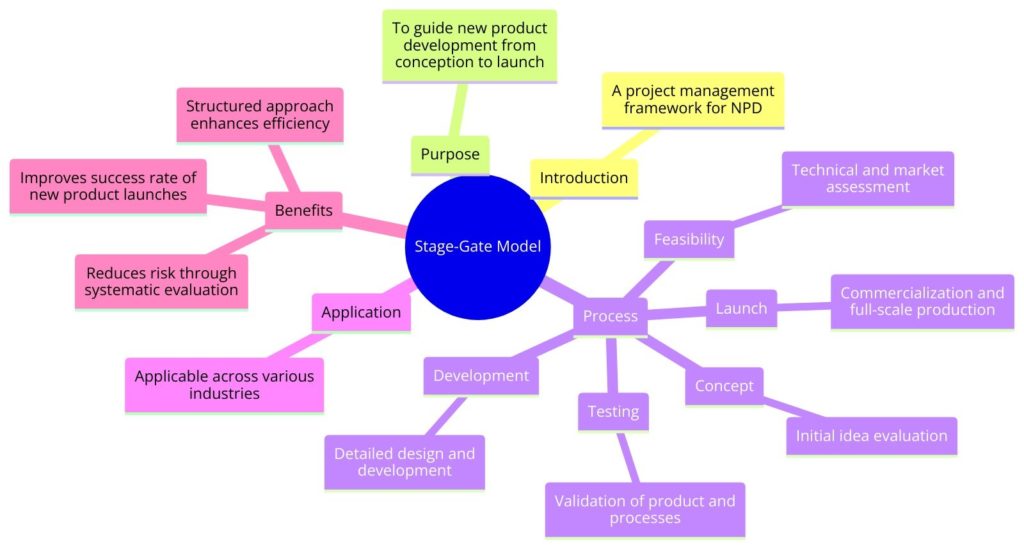Stage-Gate Model
The Stage-Gate Model is a project management framework designed to guide new product development (NPD) processes from conception to launch. Developed by Dr. Robert G. Cooper in the 1980s, this model introduces a structured approach that segments the innovation process into distinct stages, separated by decision points or “gates.” It has since become a staple in product development practices, helping organizations streamline their innovation processes, improve success rates, and bring products to market more efficiently.
What is the Stage-Gate Model?
The Stage-Gate Model breaks down the complex process of developing new products into manageable stages, each focusing on a specific aspect of the development process. Between each stage, there is a gate where key decision-makers evaluate the project’s progress, review findings, and decide whether to continue, redirect, or halt the project. This systematic approach aims to minimize risk and allocate resources more effectively by making informed decisions at each gate.
Origin of the Framework
Dr. Robert G. Cooper introduced the Stage-Gate Model based on his research into why some products succeed while others fail. His studies identified a lack of structured process management as a key factor in many NPD failures. Cooper’s work culminated in the publication of several books and articles detailing the model, and it has been refined over the years to adapt to changing business environments and technological advancements.
How It Works
The Stage-Gate Model typically involves the following stages:
- Idea Generation: Collecting, creating, and evaluating potential product ideas.
- Scoping: Conducting a preliminary assessment of the technical merits and market potential of the selected ideas.
- Business Case Development: Creating a more detailed analysis, including feasibility studies, market research, and financial evaluations.
- Development: Turning the idea into a tangible product, involving detailed design, testing, and validation processes.
- Testing and Validation: Subjecting the product to rigorous tests in real-world scenarios, evaluating its performance, and refining it based on feedback.
- Launch: Final preparations for commercializing the product, including production ramp-up, marketing strategy development, and sales channel preparation.
At the end of each stage, a gate serves as a checkpoint where project leaders review progress and decide on the next steps based on predefined criteria.
Why It Is Valuable
The Stage-Gate Model provides numerous benefits, including:
- Risk Management: By evaluating projects at several critical points, companies can identify potential issues early and take corrective action, minimizing risks and resource wastage.
- Increased Efficiency: Structuring the NPD process helps streamline development, reduce time to market, and improve coordination among teams.
- Enhanced Decision-Making: Gates provides structured decision points, facilitating more informed and timely decisions based on the latest project data.
- Resource Optimization: The model allows for better allocation of resources, ensuring that only promising projects receive investment.
When and How to Use It
The Stage-Gate Model is versatile and can be applied to various industries and types of product development projects. It is particularly useful for organizations seeking to:
- Implement a structured NPD process.
- Improve success rates of new products.
- Streamline development and reduce time to market.
- Enhance cross-functional collaboration in product development.
To implement the Stage-Gate Model effectively, organizations should:
- Define clear objectives and criteria for each stage and gate.
- Establish a cross-functional team to oversee the process and make gate decisions.
- Train team members on the model’s principles and practices.
- Regularly review and refine the process to ensure it remains aligned with organizational goals and market conditions.
Shortcomings/Criticisms
Despite its widespread adoption, the Stage-Gate Model has faced criticism, including:
- Inflexibility: Critics argue that the model can be too rigid, limiting creativity and adaptability in rapidly changing markets.
- Bureaucracy: The formal gate processes can create bureaucratic overhead, potentially slowing down innovation.
- Focus on Elimination: The model’s emphasis on risk management and decision gates can lead to the premature termination of projects that might have succeeded with more time or resources.
The Stage-Gate Model is a valuable tool for managing the complexities of new product development. By providing a structured framework for advancing projects from conception to launch, it helps organizations minimize risks, optimize resources, and bring new products to market more effectively. However, to maximize its benefits, companies may need to adapt the model to fit their unique culture, industry dynamics, and innovation goals.


